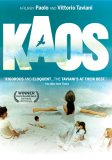| Reviews & Columns |
|
Reviews DVD TV on DVD Blu-ray 4K UHD International DVDs In Theaters Reviews by Studio Video Games Features Collector Series DVDs Easter Egg Database Interviews DVD Talk Radio Feature Articles Columns Anime Talk DVD Savant Horror DVDs The M.O.D. Squad Art House HD Talk Silent DVD
|
DVD Talk Forum |
|
|
| Resources |
|
DVD Price Search Customer Service #'s RCE Info Links |
|
Columns
|
|
|
Kaos
Arriving to US shores for the first time ever Kaos (1984), the Tavianis homage to Luigi Pirandello's "Novelle per un anno" (Short Stories for a Year), offers a deeply poetic look at the folklore legacy of Sicily. Commissioned by RAI, the Italian national broadcaster, pic boasts impressive panoramic vistas, literary references, as well as beautifully arranged melodies blending perfectly with the poetic spirit of its five stories.
"The Other Son", "Moonsickness", "The Jar", "Requiem", and "The Crow of Mizzaro" tell stories about struggling Sicilians battered by poverty. All of the five pieces are linked by the presence of a black crow which the audience is given a quick glimpse at during the opening scene of "The Other Son". The bird is largely used to enhance the film's visual referencing to traditional Sicilian customs and rules.
In the first story an old woman (Margarita Lozano) attempts to soften the pain from a past filled with misery. On a dusty crossroad where a group of immigrants prepare to leave Sicily she tells a powerful tale. In "Moonsickness" a young couple must confront old demons by learning to understand each other - the wife (Enrica Maria Modugno) discovers that her husband (Claudio Bigagli) is an epileptic with violent outbursts. "The Jar" follows the desperate efforts of Don Lollo (Ciccio Ingrassia), the owner of a fancy olive jar, as he attempts to figure out why it constantly breaks. In "Requiem" relatives battle each other while getting ready to bury their mother. Finally, in the film's epilogue, "Conversing with Mother", Luigi Pirandello (Omero Antonutti) recalls his childhood years while talking to the spirit of his deceased mother.
Similar to previous Tavianis films Kaos thrives on its creators' impressive ability to capture the colorfulness of life in Sicily, the customs and traditions Sicilians are famous for. Not surprisingly the film's greatest strength stems from its ability to recreate a realistic environment where the main protagonists never evolve into literary figures without identity. On the contrary, they breathe, move, loath, struggle, and love just as we do, though in a much more expressive manner.
Stylistically Kaos also impresses with its ability to achieve a great deal of detail in short episodes obviously meant for TV. The beginning and ending of each episode is clearly defined even though there is an element of continuity. Still, it is particularly striking to witness how quickly each of the main protagonists engages the audience while completely ignoring the time limitations. As a result Kaos does not feel as made for TV production but a full blown motion picture project.
Finally, even with the distinctively poetic beauty oozing from its five stories, at times more welcoming of knights and dragons rather than unshaved Sicilian immigrants bidding goodbye to their land, Kaos remains a work filled with plenty of realism - not the gritty and dramatic type witnessed in the films of Rossellini and De Sica but a socially-aware yet immersed in folklore realism only the Tavianis managed to achieve.
How Does the DVD Look?
Once again 1.66:1 appears to be a problematic ratio for US distributors. Slightly cropped to 1.78:1 and enhanced for widescreen TVs Kaos appears to be carrying exactly the same print seen in the French Taviani Brothers boxset released by MK2. The difference between the two transfers is practically unnoticeable - aside from the slightly softer picture here and a color scheme that appears a bit more redish the two transfers are identical. There are a few dust spots here and there as well as a few tiny scratches in the opening scenes but aside from that the quality of the print is indeed acceptable. Contrast and detail are not as strong as in The Night of the Shooting Stars but nevertheless I fairly certain that this is the best Kaos would look on DVD. Finally, those of you with larger progressive sets are likely to notice areas of the print with strong macro-blocking patterns towards the second half of the film.
How Does the DVD Sound?
Presented with a DD Italian track and optional, yellow, English subs the audio treatment is in fact slightly better than the audio presentation. Dialog is very easy to follow and I could not detect any disturbing pop-ups/hissing etc.
Extras:
Once again, the only extra here is the lovely booklet with an informative essay by Distinguished Professor Emeritus of Film Studies and Italian at Indiana University-Bloomington Peter Bondanella. In it, there is a concise description of the history behind this project as well as its placement within the Tavianis legacy of films.
Final Works:
I am particularly happy to see that Koch Lorber Films are bringing these lesser seen Tavianis films to North America. Together with The Night of the Shooting Stars and Florile, Kaos is an excellent introduction to the world of two of Italy's most distinguished film directors. Recommended.
|
| Popular Reviews |
| Sponsored Links |
|
|
| Sponsored Links |
|
|
| Release List | Reviews | Shop | Newsletter | Forum | DVD Giveaways | Blu-Ray | Advertise |
|
Copyright 2024 DVDTalk.com All Rights Reserved. Legal Info, Privacy Policy, Terms of Use,
Manage Preferences,
Your Privacy Choices | |||||||














